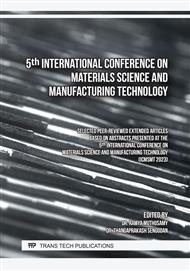[1]
K.J. Zeleznak and R. C. Hoseney, The Glass Transition in Starch, American Association of Cereal Chemists,64(1987) 121-124
Google Scholar
[2]
B. R.Krueger,C .E. Walker, C. A. Knutson and G. E. Inglett , Differential Scanning Calorimetry of Raw and Annealed Starch Isolated from Normal and Mutant Maize Genotypes, Cereal Chem 64(3) (1987)187-190
Google Scholar
[3]
Filitz Altay and Sundaram Gunasekaran, Influence of Drying Temperature,Water Content and Heating Rate on Gelatinization of Corn Starches,J.Agric.Food Chem 54 (2006) 4235-4245
DOI: 10.1021/jf0527089
Google Scholar
[4]
M.S. Almari, I. M.Al-Ruquie, A. A. Mohamed and J .Xu, Gelatinization kinetics of corn and chickpea starches using DSC, RVA and dynamic rheometry Quality Assurance and Safety of Crops & Foods 7(4) (2015) 459-468
DOI: 10.3920/qas2013.0374
Google Scholar
[5]
S . Balasubramanian, Apramita Devi, K.K. Singh, S. J .D. Bosco and Ashish Mohite, Application of Glass Transition in Food Processing Critical Reviews in Food Science and Nutrition 56 (2016) 919-936
DOI: 10.1080/10408398.2012.734343
Google Scholar
[6]
Mohammad Shafiur Rahman, Water Activity and Glass Transition in Foods Reference Module in Sciences, Elsevier Inc.2016.
Google Scholar
[7]
Dominique Champion, Martine Le Meste and Denise Simatos, Towards an improved understanding of glass transition and relaxation in foods: molecular mobility in the glass transition range, Trends in Food Science 11 (2000)41-55
DOI: 10.1016/s0924-2244(00)00047-9
Google Scholar
[8]
C.A. Angell,1985 Spectroscopy Simulation and Scattering and the medium range order problems in glass, Journal of Non- Crystalline Solids 73 (1985),1-17
DOI: 10.1016/0022-3093(85)90334-5
Google Scholar
[9]
G. W.White and S.H. Cakebread,The Glassy State in certain sugar containing food products J Food Technol 1(1966) 73-82
DOI: 10.1111/j.1365-2621.1966.tb01031.x
Google Scholar
[10]
H. Levine and L. Slade, A polymer physico-chemical approach to study the commercial starch hydrolysis products (SHPs) Carbohyd. Polym 6(2) (1986)13-44
DOI: 10.1016/0144-8617(86)90021-4
Google Scholar
[11]
L.Slade and H.Levine ,Structural stability of intermediate moisture foods-a new Understanding in: Food Structure -Its creation and evaluation pp.115-147,Blanshard,J.MV and Mitchell, J.R Eds 1988 Butterworths London
DOI: 10.1016/b978-0-408-02950-6.50013-3
Google Scholar
[12]
C.A. Angell, Spectroscopy simulation and scattering, and the medium range order in glass, J. Non-Cryst. Solids 73 (1985) 1–17
DOI: 10.1016/0022-3093(85)90334-5
Google Scholar
[13]
D. Champion, M. Le Meste, and D.Simatos,Towards an improved understanding of glass transition and relaxations in foods: molecular mobility in the glass transition range. Trends in Food Science & Technology 11(2000) 41-55
DOI: 10.1016/s0924-2244(00)00047-9
Google Scholar
[14]
B.Borde, H. Bizot, G. Vigier and A. Buleon , Calorimetric analysis of the structural relaxation in partially hydrated amorphous polysaccharides. I. Glass transition and fragility. Carbohydrate polymers 48 (2002)83-96.
DOI: 10.1016/s0144-8617(01)00217-x
Google Scholar
[15]
J.A. Augis and J.E. Bennett, Calculation of the Avrami Parameters for Heterogenous Solid State Reactions Using a Modification of the Kissenger Method, J.Thermal Analysis, 13(1978) 283
DOI: 10.1007/bf01912301
Google Scholar
[16]
T.M. Lasocka,The effect of scanning rate on glass transition temperature of splat cooled Te85Ge15 Mater.Sci.Eng. 23 (1976) 173-177
DOI: 10.1016/0025-5416(76)90189-0
Google Scholar
[17]
H. Vogel, The law of relation between the viscosity of liquids and temperature Phys. Z 22 (1921) 645-646
Google Scholar
[18]
G.S. Fulcher, Analysis of recent measurements of viscosity of glasses J.Amer. Ceram.Soc 8 (1925)339-355
Google Scholar
[19]
G.Tammann and W.Hesse, The dependence of viscosity upon the temperature of supercooled liquids Z.Anorg.Allg.Chem 156 (1925) 245-257
Google Scholar



